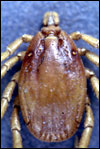The World Health Organization office in Pakistan has reported two cases of the tick-borne viral disease, Crimean-Congo hemorrhagic fever, during the month of May, according to Weekly Epidemiological Bulletin for week 20.
The details on the cases are as follows. From Balochistan province:
Reported from FJCH, Quetta. Case was shepherd by occupation. According to medical history, he developed high grade fever with bleeding per rectum and per mouth a week before and become unconscious. Lab investigation reveals Hb 11.2 g/dl, platelets 28,000/cmm, Urea 120 mg%, Creatinine 2.2 mg%, Malaria was negative.
The blood sample was collected earlier which was found positive for CCHF. There was no travelling history. Supportive treatment along with 8 pints of platelets was transfused but patient developed renal failure and passed away on 9th May 2014. No more cases identified in the family or surrounding.
From Khyber Pakhtunkhwa province:
40-year-old was admitted in Isolation Room of Khyber Teaching Hospital, Peshawar with history of Fever, Myalgia, Mucosal Bleeding and Hypotension. Surveillance Officer DEWS investigated the case.
By profession the case is Milkman and belongs to Saraey Norang in district Lakki. He worked in a private farm in KARAK when he developed the symptoms. His platelets count were less than 50000/mm3. Blood sample was taken and sent to NIH and was found positive for CCHF. Barrier Nursing was ensured at hospital, but the patient could not survived and expired on 14th May 2014. Surveillance Officer and DoH in DIKhan informed and requested to conduct the field investigation in Lakki.

Image/ CDC
According to the WHO, Crimean-Congo haemorrhagic fever (CCHF) is a widespread disease caused by a tick-borne virus (Nairovirus) of the Bunyaviridae family. The CCHF virus causes severe viral haemorrhagic fever outbreaks, with a case fatality rate of 10–40%. For more infectious disease news and information, visit and “like” the Infectious Disease News Facebook page.
CCHF is endemic in Africa, the Balkans, the Middle East and Asian countries south of the 50th parallel north – the geographical limit of the principal tick vector. The hosts of the CCHF virus include a wide range of wild and domestic animals such as cattle, sheep and goats.
Animals become infected by the bite of infected ticks and the virus remains in their bloodstream for about one week after infection, allowing the tick-animal-tick cycle to continue when another tick bites. Although a number of tick genera are capable of becoming infected with CCHF virus, ticks of the genus Hyalomma are the principal vector.
The CCHF virus is transmitted to people either by tick bites or through contact with infected animal blood or tissues during and immediately after slaughter. The majority of cases have occurred in people involved in the livestock industry, such as agricultural workers, slaughterhouse workers and veterinarians. Human-to-human transmission is possible.

